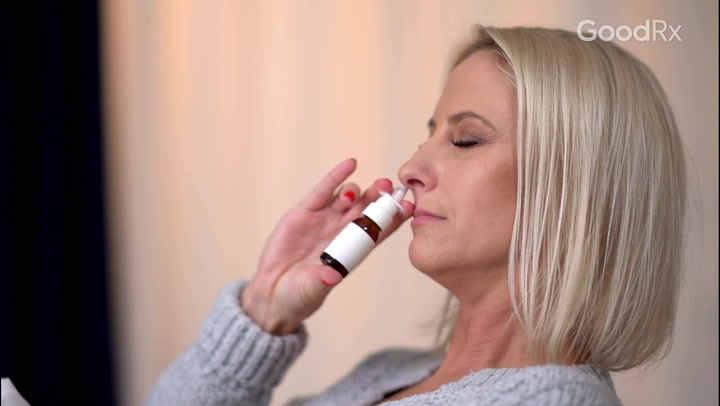
Sudafed and Zyrtec: Can You Take Them Together?
Key takeaways:
Sudafed (pseudoephedrine) and Zyrtec (cetirizine) are both over-the-counter (OTC) medications that can help with allergy symptoms. They work in different ways: Sudafed is a decongestant, and Zyrtec is an antihistamine.
You can take Sudafed and Zyrtec together, as long as it’s safe for you to take either one alone. But you shouldn’t take Zyrtec-D (cetirizine / pseudoephedrine) with Sudafed since they both contain pseudoephedrine.
You can usually take Sudafed and Zyrtec alongside other allergy medications, as long as you avoid duplicating antihistamines or decongestants. Always check with your primary care provider and pharmacist before starting a new medication for allergies.
Access savings on related medications
Table of contents

It’s that time of the year again: The sun is shining, the temperature is rising, and the smell of spring is in the air. But with spring comes allergy season and all the sneezing, congestion, and runny noses associated with it.
If you have seasonal allergies, you likely know there are several over-the-counter (OTC) treatments available. Sudafed (pseudoephedrine) and Zyrtec (cetirizine) are two popular options. But can you take both? In short, yes, it’s safe to take Sudafed with Zyrtec. Let’s discuss.
Are Sudafed and Zyrtec the same?
No, even though they can both help with nasal allergy symptoms, Sudafed and Zyrtec are not the same. Sudafed is a decongestant, and Zyrtec is an antihistamine.
Search and compare options
Decongestants tighten the blood vessels in and around the nose and sinuses. This helps relieve swelling and congestion in these areas, making it easier to breathe. Antihistamines block the chemical histamine in the body. Histamine release causes common allergy symptoms, such as sneezing and runny nose.
Sudafed
Sudafed is a decongestant that treats nasal and sinus congestion.
Possible side effects of Sudafed include:
Trouble sleeping
Restlessness
Nervousness
Tremor
Headache
Nausea
Raised blood pressure
Fast heartbeat
Confusion or agitation
Sudafed works quickly — about 30 to 60 minutes after taking it. But it’s only meant for short-term use (no more than 7 days in a row). Long-term use raises your risk of more serious side effects, such as raised blood pressure. If you feel like you need to take it for longer than 7 days, reach out to your primary care provider (PCP).
You shouldn’t take Sudafed if you have heart problems or high blood pressure. It’s also recommended to avoid it if you have diabetes. Sudafed can worsen these conditions, even if they’re well-managed otherwise.
Sudafed is kept behind the pharmacy counter due to a risk of misuse and dependence. There are also limits on how much you can buy per day and per month. Your pharmacist can provide more details on Sudafed restrictions in your area.
Comparing options: Learn about the differences between the types of allergy medications so you can choose the right one for you.
How to relieve a stuffy nose: Experts cover what actually works for sinus congestion and pain, from medications to home remedies.
Mistakes to avoid: Decongestants can be a convenient option for a stuffy nose. Learn how to avoid common mistakes people make while taking them.
Zyrtec
Zyrtec is a second-generation (newer) antihistamine. It tends to cause fewer side effects than first-generation (older) antihistamines, such as Benadryl (diphenhydramine).
Possible side effects of Zyrtec include:
Drowsiness
Fatigue
Dry mouth
Dizziness
Stomach upset
Headache
Cough
Zyrtec takes about 20 to 60 minutes to start working. And most people can safely take antihistamines long term. If you’re trying to prevent allergies, it’s recommended to start taking Zyrtec about 2 weeks before you’d expect symptoms to start.
Talk to your PCP before taking Zyrtec if you have kidney or liver issues. These organs help break down and remove the medication. People with kidney or liver issues may have a greater risk of side effects with Zyrtec.
Can you take Zyrtec and Sudafed together?
Yes, Zyrtec and Sudafed can be taken together. There are no interactions between the medications, and they work in different ways. In fact, there is a combination product called Zyrtec-D (cetirizine / pseudoephedrine). It combines Zyrtec and Sudafed into one tablet, so you don’t have to take as many pills per day.
So, as long as it’s safe for you to take either one of these medications on their own, you can take them at the same time. But always check with a healthcare professional before taking a new medication. And as mentioned above, you shouldn’t take medications containing Sudafed for more than 7 days in a row.
Keep in mind that Sudafed works mostly on nasal congestion. So if you are having itchy eyes or other allergy symptoms, Sudafed may not help. Also, you may only need to take one of the medications to help manage all your symptoms. It’s generally best to avoid taking medications you don’t need.
What about taking Zyrtec-D and Sudafed together?
No, you shouldn’t take Zyrtec-D and Sudafed together.
Zyrtec-D already contains pseudoephedrine (Sudafed’s active ingredient). Taking both together may cause you to take too much Sudafed. And this can lead to excessive or harmful side effects, such as palpitations and a racing heart.
Read the OTC label of the products you have before combining them. This can help you make sure you’re not duplicating active ingredients. But if you’re unsure whether the Zyrtec product you have is safe to take with Sudafed, contact your pharmacist.
Sudafed and Zyrtec interactions with OTC medications
Sudafed and Zyrtec interact with several other OTC medications. So it’s important to check with a healthcare professional before taking any new medications or supplements.
Below is a table that provides a list of common cold and allergy medications that are safe and unsafe to take with Sudafed or Zyrtec. This isn’t a comprehensive list. Be sure to give your healthcare team an updated medication list so they can help prevent or manage interactions.
Safe to take with | NOT safe to take with | |
|---|---|---|
• Allegra (fexofenadine) • Astepro (azelastine) • Benadryl • Chlorphenirmine • Claritin (loratadine) • Flonase (fluticasone) • Mucinex (guaifenesin) • Pataday (olopatadine) • Saline spray • Saline rinses (neti pot) • Zaditor (ketotifen) • Zyrtec | • Afrin (oxymetazoline) • Allegra-D (fexofenadine / pseudoephedrine) • Claritin-D (loratadine / pseudoephedrine) • Mucinex D (guaifenesin / pseudoephedrine) • Zyrtec-D | |
Zyrtec | • Afrin • Flonase • Mucinex • Saline spray • Saline rinses | • Allegra • Allegra-D • Astepro* • Benadryl • Chlorphenirmine • Claritin • Claritin-D • Pataday* • Zaditor* • Zyrtec-D |
*There is not enough research on the combination of Zyrtec with this medication. It’s best to avoid it unless a healthcare professional tells you it’s OK to use both.
Other oral antihistamines
If you’re taking Zyrtec, you should avoid other oral antihistamines unless a healthcare professional tells you otherwise. This includes older antihistamines, such as Benadryl and chlorpheniramine. It also includes newer antihistamines, like Claritin or Allegra.
Taking too many oral antihistamines at once raises your risk for side effects without providing more symptom relief. And in rare cases, it could lead to dangerous overdose symptoms.
On the other hand, Sudafed is safe to combine with an oral antihistamine, including Claritin, Benadryl, and others. Just avoid mixing it with products that have “D” at the end of the name, such as Claritin-D. The “D” stands for decongestant. And it means the product contains pseudoephedrine.
Nasal sprays
There are a few different OTC allergy nasal sprays available:
Antihistamine nasal sprays, such as Astepro
Decongestant sprays, such as Afrin
Nasal steroid sprays, such as Flonase
Saline nasal sprays, such as Ocean Nasal Spray
You can safely combine Sudafed with nasal steroids, nasal antihistamines, and saline sprays. Avoid using both Sudafed and a decongestant spray. Both medications work in similar ways to relieve congestion. You may have a greater risk of certain side effects, such as headache, if you use both. And there’s no added benefit to combining them.
It’s safe to combine Zyrtec with most OTC allergy nasal sprays, except antihistamine sprays. There isn’t much research on whether using Zyrtec and an antihistamine nasal spray is safe or works well. But even though other combinations are safe, studies suggest they may not work any better than using a nasal spray by itself.
Antihistamine eye drops
If you have mostly eye-related symptoms (itching, irritation, burning, or redness), OTC antihistamine drops, like Zaditor and Pataday, can be helpful. But if you’re taking Zyrtec, check with a healthcare professional before using them. Similar to above, this combination hasn’t been well studied.
Antihistamine eye drops can be combined with Sudafed, as long as it’s safe for you to take either medication alone.
Saline rinses
Other OTC products to treat allergy symptoms include saline rinses, such as a neti pot, which help with nasal congestion. The salt water in these treatments helps break up mucus in the nose and causes minimal to no side effects. Zyrtec or Sudafed can be combined with saline nasal rinses or sprays.
Expectorants
Mucinex (guaifenesin) is the only expectorant available OTC. It helps relieve chest congestion by thinning the mucus in your airways. This makes it easier to cough mucus up. Mucinex has no known drug interactions. This means it’s safe to take Sudafed or Zyrtec with Mucinex.
But be sure to read the OTC label of your chosen product. The makers of Mucinex make several other combination medications. Some of these may contain other active ingredients that interact with Sudafed or Zyrtec.
For example, Mucinex D (guaifenesin / pseudoephedrine) contains the same decongestant as Sudafed. And products in the Mucinex Nightshift line each contain an antihistamine, which would interact with Zyrtec.
How to save on Sudafed and Zyrtec
There are ways to save on Sudafed and Zyrtec, which are available as both brand-name and generic medications. By having a healthcare professional write a prescription for them, GoodRx can help you save over 75% off the average retail price.
Generic Sudafed's price at certain pharmacies is as low as $4.20 with a free GoodRx discount. And generic Zyrtec’s price may be as low as $3.16.
The bottom line
Zyrtec (cetirizine) and Sudafed (pseudoephedrine) are two common over-the-counter (OTC) medications that can help treat allergies. Zyrtec is an antihistamine, while Sudafed is a decongestant. As an antihistamine, Zyrtec can help with many allergy symptoms, while Sudafed primarily helps with nasal congestion. These medications can usually be taken together, as long as it’s safe for you to take either medication alone.
Zyrtec and Sudafed can be taken with other OTC medications. But you generally shouldn’t take more than one antihistamine or more than one decongestant at a time, unless directed otherwise by a healthcare professional. Your healthcare team can help make sure the combination of allergy medications you’re taking is safe for you.
Why trust our experts?



Family Doctor. (2023). Decongestants: OTC relief for congestion.
Head, K., et al. (2018). Saline irrigation for allergic rhinitis. The Cochrane Database of Systematic Reviews.
MedlinePlus. (2017). Histamine: The stuff allergies are made of.
Naqvi, A., et al. (2024). Cetirizine. StatPearls.
PDR by ConnectiveRx. (n.d.). Mucinex.
Seidman, M. D., et al. (2015). Clinical practice guideline: Allergic rhinitis. Otolaryngology–Head and Neck Surgery.

























